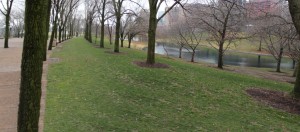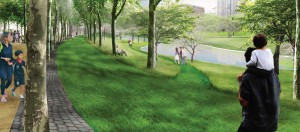This is a follow-up on the plan to replace the declining ash trees near the Arch with London plane trees (Platanus x acerifolia). Some members of Wild Ones who contacted CityArchRiver 2015 to express concerns about the use of a monoculture of non-native trees received this response from Ryan McClure, Communications Director.

Ash trees along the current walkway to the Arch. Image from CityArchRiver. Click for a larger image.
We are glad to hear of your interest in the project and would like to respond to the concerns you have about tree selection on the Arch grounds. Following is information provided by our design team that may help address your inquiry and provide some insight and reasoning behind the choices made for the revitalization of the Arch grounds.
The National Park Service recently announced its decision to replace the endangered Ash trees on the processional allees of the Arch grounds with the London Plane tree after an extensive process that involved input from the CityArchRiver design team, the Missouri Department of Conservation, Missouri Botanical Garden, local arborists and nurserymen, and many others.

Artist’s rendering of the proposed London plane trees along the walkway. Image from CityArchRiver.
The Processional walks and single species allee trees are an iconic component of the landscape and important for the role they play within the designated historic landmark original design as conceived by Saarinen and Kiley. The challenge here is choosing an appropriate tree for this distinct allee. Even mixing three or four trees that are adaptable to a paved tree pit application is problematic if one of those species were to succumb to a disease and lead to an irregular allee. For both aesthetics and more consistent maintenance a single tree species is actually better. These 860 trees will be nurtured and maintained within a beneficial mutually supportive ecology; it is easier to maintain subsurface soil moisture, nutrients and beneficial endo-mycorrhizal colonies for one tree species than three or four all planted next to each other. It is also worth noting that the London Plane tree, which is a hybrid of American Sycamore and Oriental Plane tree, is a proven disease-resistant, urban tree with growth characteristics and hardiness better suited for planting in pavement situations. The true native Sycamore is not adaptable to sidewalk conditions.
More importantly, to your concern that we are not providing native plantings, the majority of the Arch Grounds will be dedicated to native tree and forest planting as the original designers also intended. In addition to the existing native trees, an additional 1,000+ trees will be added for a total of almost 1,500 mixed native trees on the Arch grounds. Many of these trees will be of the oak, birch, and hickory family. These areas will be a great learning opportunity for visitors and citizens alike to learn the benefits of Midwestern ecosystems of flora and fauna. Our design team actually contains people that are interested in insects and the sub-surface endo-mycorrhizal fungi communities that make plant growth healthy in a mutually beneficial way without the use of synthetic support such as common fertilizers. This will be a great educational opportunity we feel the project can bring to all ages of visitors and citizens.
We hope this information helps ease some of your concerns and provide information about how these decisions are made.
Thank you,
Ryan McClure
Communications Director
CityArchRiver 2015 Foundation

